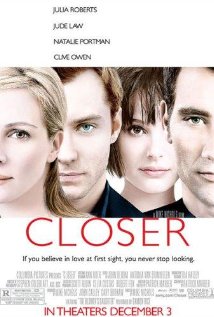
CLOSER
US, 2004, 104 minutes, Colour.
Julia Roberts, Jude Law, Natalie Portman, Clive Owen.
Directed by Mike Nichols
Patrick Marber has adapted his award-winning play for the screen. However, it still seems very much a filmed play, relying on (very frank) dialogue, with much of the action happening off-screen and the time lapses between acts left for the audience to work out for themselves. It has been pointed out that director Mike Nichols' first film was Edward Albee's Who's Afraid of Virginia Wolf almost forty years earlier. Closer has similar themes: sexuality, love, marriage, betrayal, cruelty.
This is a film about very unhappy people. They grope (often literally) for happiness which always seems to elude them. It is very hard to empathise with them even though we know that this is the kind of struggle and depression that many people experience.
The initial focus is on an obituary writer played by Jude Law. He meets a young American stripper (Natalie Portman) after she is knocked over by a car in a London street. In no time, he has written a novel based on her life and they are living together. When he is being photographed for the book's cover, he is attracted by the photographer (Julia Roberts). The fourth partner is a doctor (Clive Owen) who dallies in internet sex chat rooms (a powerful sequence highlighting the impersonal deceit of such communication and its indulgent lechery), is set up to meet the photographer and lives with her.
The emotional immaturity of the characters takes its toll as they betray each other, the only one eliciting some sympathy being the stripper, who is the most honest of the four (and then not entirely).
The acting is to be admired. The dialogue is sparse, sometimes crude, sometimes incisive, sometimes cruel. In fact, it is a grim drama of suffering people whose torment is often of their own making.
1. The title? Relationships, near and far? Close-ups of the characters? Visually? Psychologically?
2. The work of Patrick Marber, for the theatre? The opening out of the play, dialogue, situations, interactions?
3. The London settings, the city, the streets, flats, workplaces, clubs? Photographers, doctors?
4. The stylised situations, the stylised language? Local, universal?
5. The importance of the musical score, the references to Mozart, Cosi Fan Tutti?
6. The close-ups of characters, their relationships, the nature of relationships?
7. Julia Roberts is Anna, age, experience, background, relationships, her self-image, lust and love, the effect, acting on her feelings?
8. Alice, the American, the stripper, seeing Daniel in the street, hit by the taxi, in hospital, his care for her? His comment about the traffic, the Park where his father went and his mother died? The quick relationship? Time passing? The photo opportunity with Anna? Her overhearing the comments about the affair?
9. Daniel, writing obituaries, his book, the novel with Alice as a basis, the relationship with her, over the year? The photo opportunity for Alice, Daniel flirting with Anna? The kiss? And Alice coming into the room? The photograph? Daniel in the year with Anna?
10. Larry is a doctor, his type, his going on to this cybersex chatroom, pretending to be female, the interchanges with Daniel, going to the aquarium, Daniel’s response to Larry, the references to Cupid? Meeting Alice at the exhibition? The interrogation, the heavy sexual emphasis?
11. Larry, cheating? And Daniel – Anna the relationship with Larry? Alice and her real name?
12. Surfaces, deceits, cheating?
13. The possibility of genuine relationships, callow moral attitudes, self-loathing, feelings of guilt and responsibility?
14. Alice returning to the United States, New York, in the street, the glimpse of Daniel – and the circular movement of the screenplay?
15. A serious film about relationships, squalid aspects, redemptive aspects?